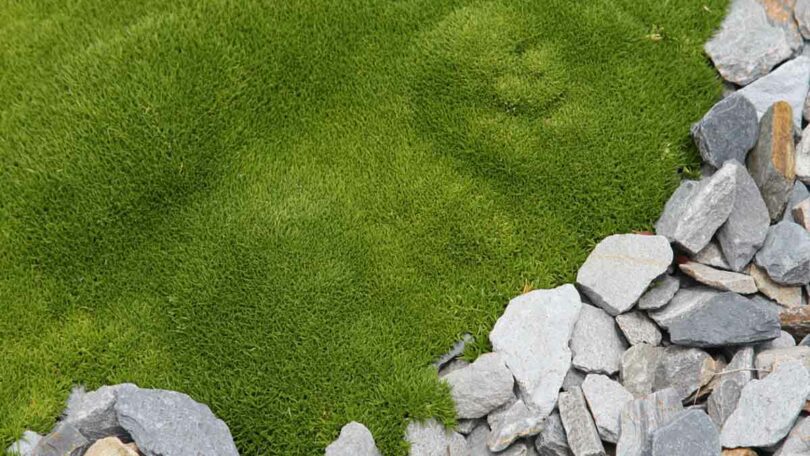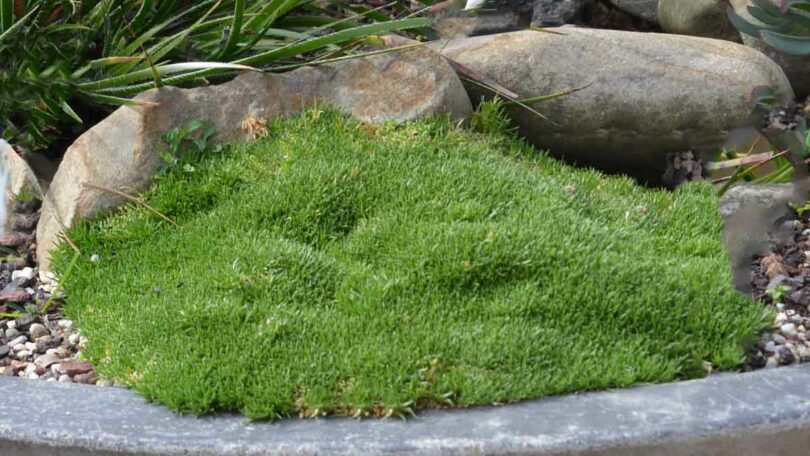
Lime Lava or Cushion Plant
One of the best native ground cover plants is Scleranthus biflorus, a mound forming plant growing to only a few cms high. It seems to flow over and around rocks in the garden, and is sometimes seen under the name ‘LimeLava ‘, referring to the colour and the flowing effect.
Found in Alpine to sub Alpine areas from Tasmania, through Victoria, to New south Wales this is a plant that requires moisture for good growth.
An easier to grow alternative for many gardeners may be Azorella trifurcata
How to Grow Scleranthus biflorus – Basic Care
The trick to growing Scleranthus biflorus is a well drained soil with moisture. It is a plant that does not like to dry out, neither does it like to be water logged.
Excellent when planted in a rock garden with some moisture it is a plant that comes into its own from spring through summer to autumn.
An interesting choice for container growing where it forms a mound that will flow over the edge of the pot.
Planting
- Position/Sun
For good growth and to prevent disease a position in full sun is important. - Soil
Scleranthus biflorus prefers a Humus rich and well drained soil.
- Watering
When first planting water as soon as they soil starts to dry in spring through summer. In winter no extra water should be needed. - Tolerances
This is a plant that will cope with dry spells, however not prolonged dry soil. It will tolerate frosts and even snow cover.
In deep shade Scleranthus biflorus does not grow well, it quickly become patchy . A little light afternoon shade may be OK depending on the climate zone. - Fertiliser
A little slow release low phosphorus native plant fertilizer in spring and some added moisture during dry spells should ensure good growth.
Landscaping Uses
Used widely as a landscaping plant, the foliage forms an attractive bright green cushion like appearance. It flows over the ground covering mounds an rocks to give an undulating sea of green.
This is a ground cover plant that looks great when planted near rocks and is allowed to mould itself to the shape. Full sun, and well drained humus rich soil.
Grow it in a container with rocks and other small plants, or perhaps beneath a bonsai tree.
Scleranthus biflorus never really reaches great heights, it will form a mound to 10 cm – 15 cm or so, and it will spread over 80 cm, even more in good conditions.
It does have a few common names, ‘Cushion Bush’, ‘Twin Flowered Knawel’ is one, ‘Canberra Grass’ is another, however the Tasmanians, Victorians and New Zealanders do not call it that.

It could be used as a lawn substitute, however it does not take foot traffic. It is also suited to underplant Bonsai specimens.
Scleranthus biflorus Propagation
Easy boy division of established clumps the best time to propagate by division is in. Spring. Make sure you water well the day before dividing and take a good section of roots with each clump.
Best grown in full sun to afternoon shade, moist but well drained soil.
Fertiliser can be used however a low phosphate native plant fertiliser is required.
Summary Information
- Botanical Name –Scleranthus biflorus
- Common Names – Lava Lime, Cushion Bush, ‘Twin Flowered Knawel’ and ‘Canberra Grass’
- Origins – Alpine areas of Victoria and New South Wales
- Position – Full Sun to Partial Shade
- Moisture – Well drained humus rich soil with some moisture
- Growth Habit – Mounding forming and spreading ground cover.
- Foliage Colour – Mid to deep Green
- Flower Colour – Yellow to Green and usually fairly inconspicuous.
- Frost Tolerant – Yes, light frosts only.
- Coastal Gardens – Only some areas
- Height – To 15cm
- Spread -To 90cm, more in good conditions
- Pruning – Not generally required.
Problems.
- Humidity
This is a plant that does not grow well in areas of high humidity. It can suffer fungal diseases in these situations. Provide good air flow to prevent this. - Heavy Soils
Die back can occur in heavy soils, often yellowing in the centre is the first indication.
In many cases this is plant that is best planted in a rock garden. The rocks lift it off the ground and this prevents much of the die back.
